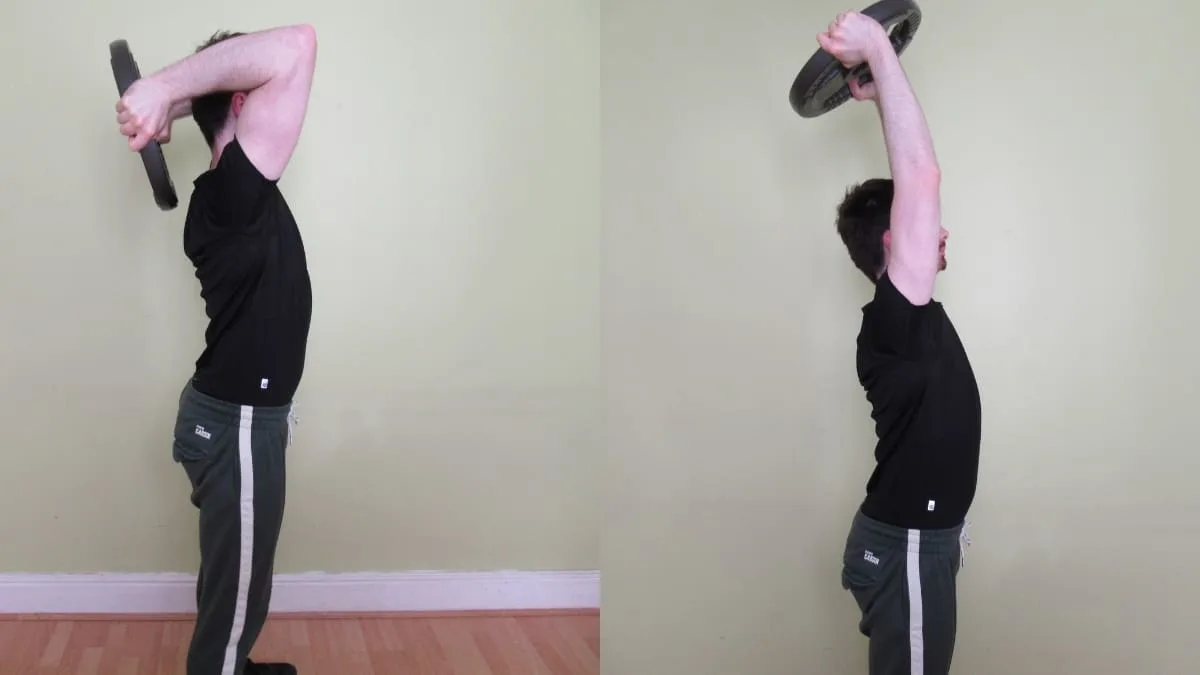The plate tricep extension is very similar (identical, in terms of movement pattern) to the dumbbell tricep extension because you’re lowering the weight behind your head and then flexing your triceps to lift it back up.
This lifting motion trains all three tricep heads while emphasizing the biggest of these heads, namely, the long head, which makes plate tricep extensions especially effective for gaining arm size.
The following guide shows you how to do 8 different tricep extensions with a plate. So regardless of your training goals and equipment availability, you’ll find an exercise that’s suitable and effective.
Plate tricep extension exercise details
- Also Known As: Weight disc tricep extension
- Main Muscles: Triceps brachii
- Exercise Type: Strength
- Exercise Mechanics: Isolation
- Difficulty Level: Beginner
- Equipment Needed: Weight plate
How to do a tricep extension with a plate
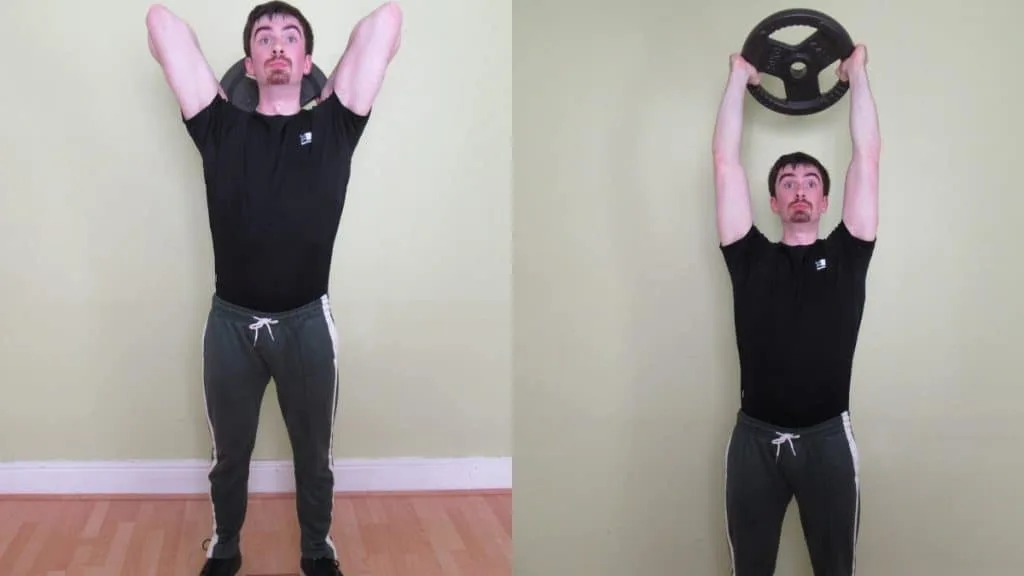
- Grab a weight plate by its sides, and then stand up straight with your neck and back aligned.
- Press the weight over your head so that your elbows are locked out.
- Lower the plate behind your head by bending your elbows.
- Descend until you feel an intense stretch in the backs of your arms (i.e., in your triceps).
- Reverse the motion by flexing your triceps.
- Keep going until your elbows are once again locked out.
- Repeat for 3-5 sets of 8-20 reps.
Plate tricep extension variations
Besides the standing overhead plate tricep extension, there are 7 additional weight plate tricep extensions that you can do to strengthen, tone, and add mass to the backs of your arms.
Seated plate overhead tricep extension

Performing a seated overhead tricep extension with a weight plate rather than doing the exercise standing up means that you’re better able to isolate your triceps. This is because you don’t have to put as much effort into stabilizing your core when your torso is braced against the bench’s back pad.
Of course, if you’ve already established a strong triceps mind-muscle connection through years of weight training, then you might not feel much difference in muscle activation between the seated tricep press and the standing version.
The lifting technique is exactly the same for both variations; you lower the plate behind your head in a controlled manner and then contract your triceps to lift it back up.
On the other hand, you may actually want to stick with the standing overhead plate tricep extension so that you can burn more calories and give your abs a good isometric workout.
It just depends on your goals. For maximum triceps hypertrophy and isolation, stick with the standing plate triceps extension. To burn more calories while challenging your abs and triceps simultaneously, go with the seated plate tricep extension.
One arm plate overhead extension
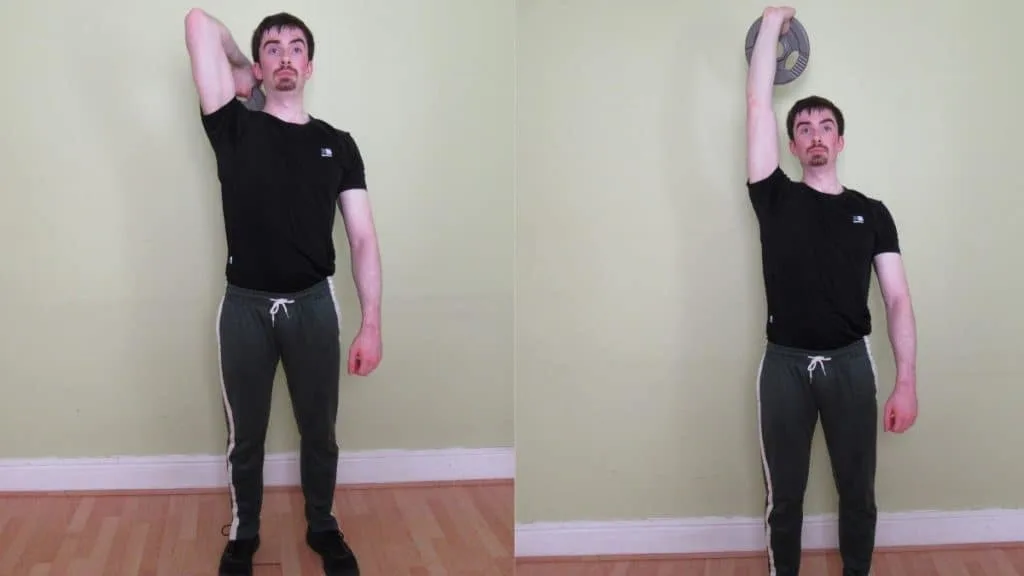
The one arm plate overhead extension is the same as the one arm dumbbell extension in terms of lifting technique, and you can do the exercise in both standing and seated positions.
However, you’ll need to use a lighter weight disc because you’re training each arm separately. The advantage is that you get to ensure that both of your triceps muscles are receiving equal amounts of work.
Giving both of your triceps similar amounts of stimulation helps your upper arms to look more proportional, which in turn improves the symmetry of your upper body, an attribute that’s crucial if you’re a physique athlete.
Just be sure to start with your weaker arm so that you can give it maximum attention and thus do everything in your power to reduce your tricep size asymmetries.
Plate press to tricep extension
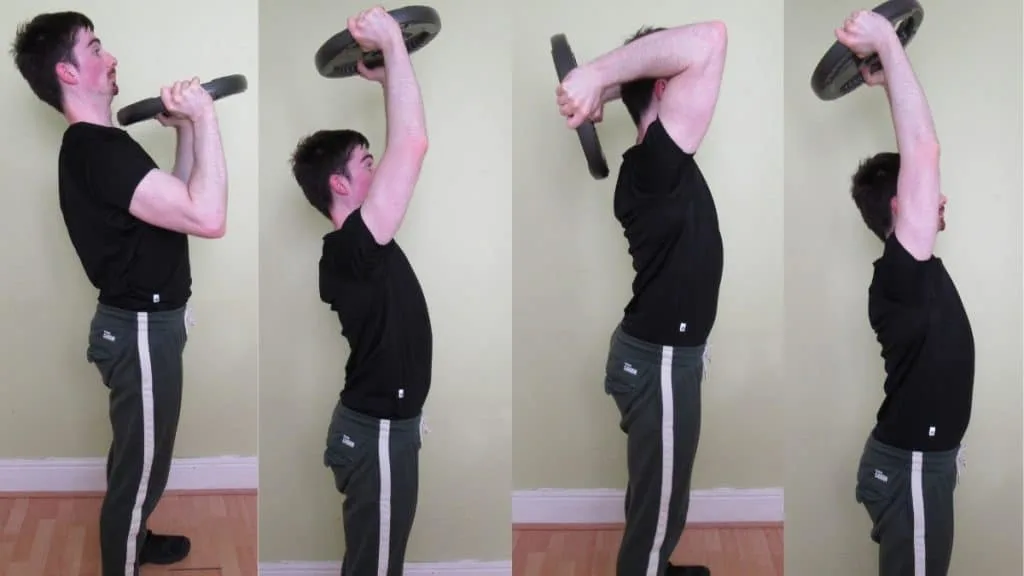
Doing a plate press to tricep extension trains your triceps and shoulders simultaneously.
The plate press to overhead extension is an intense exercise that makes an excellent final addition to any push session or upper body workout because it really pumps up your delts and tris.
You can also do an overhead tricep extension and press with a plate where you start with the overhead extension and then move into the press. It doesn’t really matter which exercise you begin with because you’re going to be doing them in a back-to-back fashion anyway.
To work more on your chest, you could even do the exercise lying down. You’d first press the weight up as if you were doing a bench press; then, you’d lower it behind your head as if you were doing a tricep extension lying down.
Lying plate tricep extension
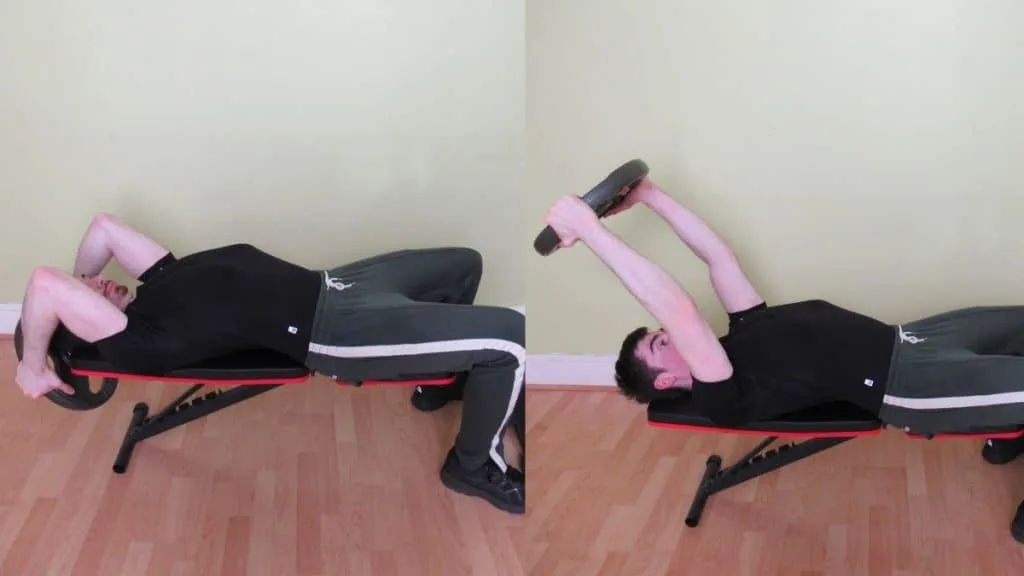
Performing skull crushers with a plate is a great way to isolate your triceps because lying on a bench means that you don’t have to brace your abs as hard, which in turn means that you can put more effort into training your triceps.
During the lying plate tricep extension, however, you should bring the weight disc behind your head to intensify the eccentric stretch and thus give the long head of your triceps a better workout.
In other words, don’t lower the plate to your face because it puts more stress on your elbows and reduces the triceps stretch during the eccentric phase of the rep. And besides, the last thing that you want to do is drop a heavy weight disc on your face!
I recommended using one larger weight plate to make the lifting motion as simple as possible (this way, you can just focus on stretching and squeezing your triceps).
Yet, if you want to work each of your triceps as equally as possible, then you can also do the exercise with a weight plate in each hand. Note, however, that this would mean using less total resistance because stabilizing two separate weight discs is harder than balancing one big plate.
Kneeling plate tricep extension

Performing a kneeling tricep extension with a dumbbell or a weight plate taxes your triceps while simultaneously challenging your core muscles. For this reason, it has excellent carryover to dynamic exercises that require a lot of abdominal strength.
The trade-off is that you won’t be able to lift as heavy as you can during standing overhead plate tricep extensions because your core strength is likely to be the limiting factor when you’re kneeling.
Training each side separately with a kneeling single arm plate tricep extension is a good way around the core stability problem. Yes, training unilaterally will take longer, but if anything, working one arm at a time will make your obliques work even harder and provide enhanced triceps isolation as well.
Also, make sure to do this exercise on a mat whenever possible. While you might be able to tolerate kneeling directly on the floor for a short amount of time, you don’t want to be focusing on the discomfort in your knees at the expense of your triceps.
Incline plate tricep extension
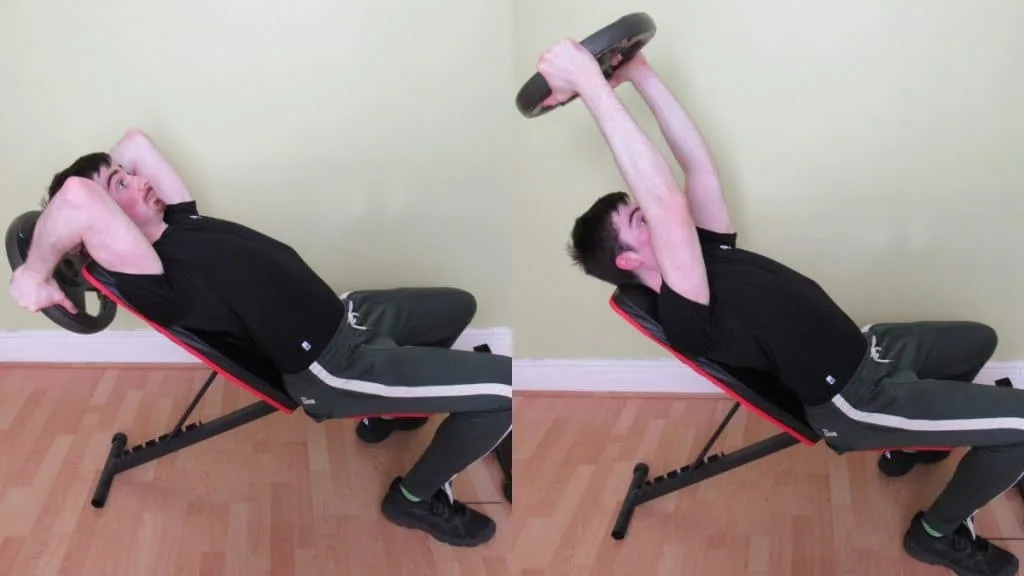
Like the dumbbell incline triceps extension, the incline plate triceps extension is a cross between overhead extensions and lying extensions.
So if you struggle to get your arms all the way behind your head during the overhead extension (which you need to do to make the exercise effective), the incline plate extension is a good exercise because it requires less shoulder mobility.
The form is exactly the same. You brace your back against the pad and then slowly lower the plate behind your head. Once you feel an intense stretch in the backs of your arms, you simply flex your triceps until your elbows reach full extension.
Just make sure to have a spotter handy if you plan on training to complete muscular failure; you don’t want to get stuck with the plate behind the backrest of the bench.
Decline tricep plate extension
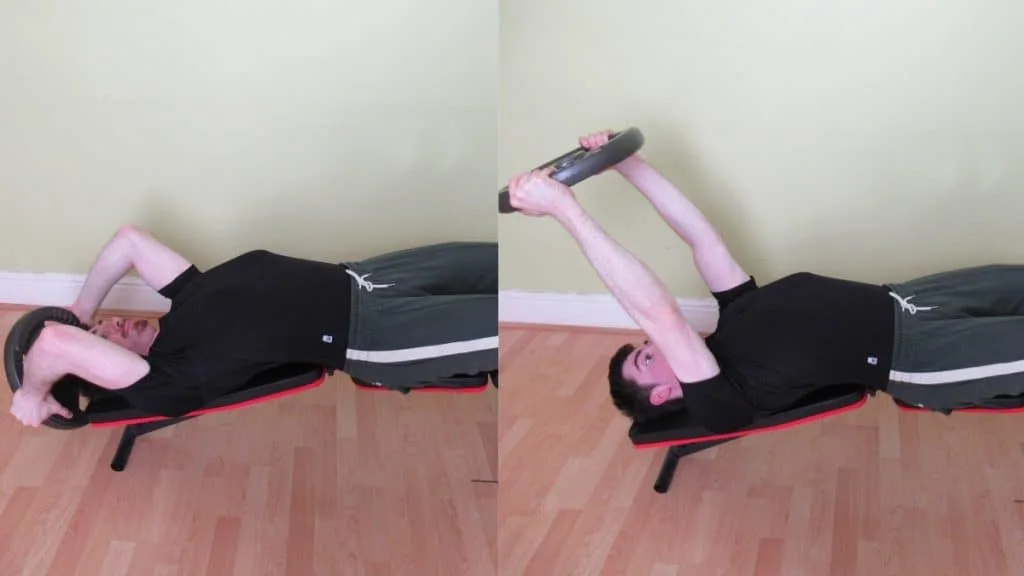
Plate decline triceps extensions, like any kind of tricep plate extension, work all three heads of the triceps.
Yet, because of the decline angle, the exercise is especially effective for building the long head of the triceps because it puts this muscle at a greater pre-stretch by placing your shoulders into a higher degree of flexion (only the long head crosses the shoulder joint).
Decline plate tricep extensions are also a very safe exercise because you can easily put the weight disc on the floor behind your head if you fail on a rep.
Conclusion: Can you do a tricep extension with a plate and still get results?
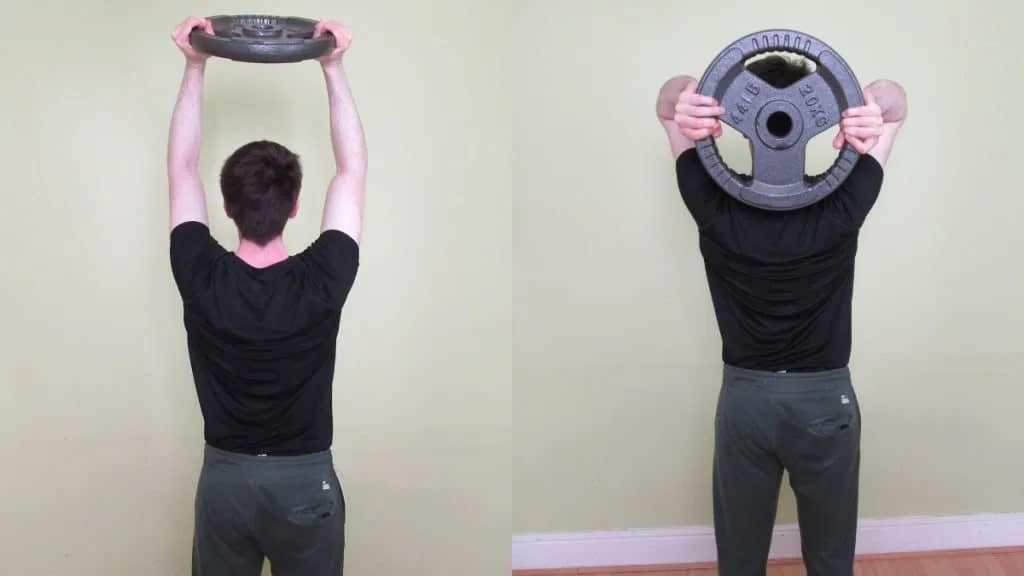
While lifting dumbbells and barbells may well be a more popular way to train than just lifting weight plates, there’s no reason why you can’t get great gains in triceps size and strength from the plate tricep extension.
Your triceps, after all, only respond to tension.
Nonetheless, plate overhead extensions do have one main drawback: Your grip strength will often be the limiting factor because it’s difficult to hold multiple large weight plates in your hands.
This somewhat defeats the purpose of this isolation exercise because your grip will be holding your triceps back.
That’s why performing the plate tricep extension as a high-rep finishing exercise is your best bet. Do sets of 12-20 reps to fatigue the remaining muscle fibers and get a good pump. Save the heavy lifting for your compound presses and other free weight training.

